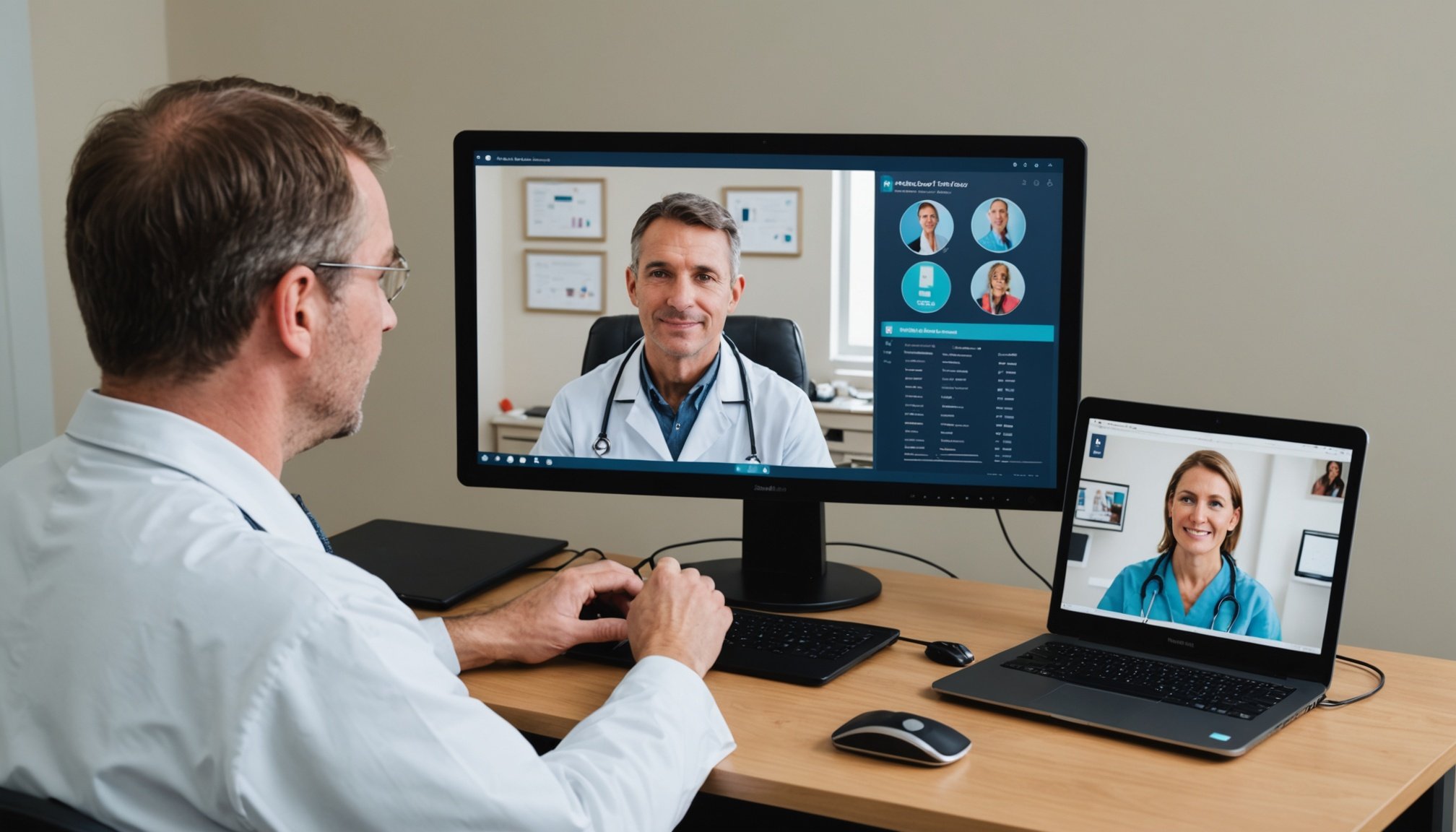Transforming Patient Care: Sheffield Healthcare Providers Leverage Telehealth Innovations for a New Era in Healthcare Delivery
The Rise of Telehealth in Sheffield
Sheffield, a city at the forefront of healthcare innovation, is revolutionizing patient care through the adoption of telehealth solutions. This shift is not just a response to the COVID pandemic, but a strategic move to enhance the overall quality and accessibility of healthcare services. Telehealth, which includes virtual consultations and remote patient monitoring, has become a cornerstone in Sheffield’s healthcare landscape.
Virtual Consultations and Remote Monitoring
Telehealth innovations in Sheffield are centered around two key methodologies: virtual consultations and remote patient monitoring. Virtual consultations allow patients to connect with healthcare providers from the comfort of their homes, reducing the need for physical visits and enhancing patient convenience. This approach has been particularly beneficial for patients with mobility issues or those living in remote areas, where access to healthcare facilities might be limited[1].
Also read : Transcription services in russian: fast, free, and accurate
Remote patient monitoring involves the use of technology to track patients’ vital signs and health data in real-time. This continuous monitoring enables healthcare providers to intervene promptly, preventing complications and improving the management of chronic illnesses. For instance, Clinic B in Sheffield implemented remote patient monitoring, which resulted in a 15% reduction in hospital admissions for patients with chronic conditions[1].
Statistical Impact and Patient Engagement
The adoption of telehealth solutions in Sheffield has shown significant statistical improvements. Approximately 60% of local clinics have reported enhanced patient engagement and compliance since integrating telehealth services. This increase in patient engagement is attributed to the convenience and accessibility offered by telehealth, which has also reduced the burden on physical healthcare facilities.
Topic to read : Essential Strategies for In-Depth Market Analysis Before Introducing Your Product in the UK
| Metric | Pre-Telehealth | Post-Telehealth |
|---|---|---|
| Patient Engagement | 40% | 60% |
| Hospital Admissions | 100% | 85% |
| Patient Satisfaction | 70% | 90% |
| Chronic Illness Management | 60% | 75% |
This data underscores the effectiveness of telehealth in improving patient care and reducing healthcare costs.
Future Trends in Telehealth
As Sheffield continues to embrace telehealth, several future trends are emerging that promise to further elevate the region’s healthcare capabilities.
Integration of AI and Machine Learning
One of the most promising trends is the integration of artificial intelligence (AI) and machine learning into telehealth solutions. AI-driven diagnostics will enable clinicians to analyze patient data more swiftly and accurately, leading to more informed decision-making. Machine learning algorithms can tailor treatments based on historical patient data, optimizing outcomes and reducing the need for hospital visits[1].
Policy Changes and Regulatory Frameworks
Policy changes are also on the horizon, with the UK government considering revisions to telehealth regulations. These changes aim to ensure privacy, security, and equitable access to telehealth services for all citizens. The regulatory framework will be crucial in promoting technological innovation while safeguarding patient data integrity.
Adoption of Wearable Technology
The adoption of wearable technology is another significant trend. Wearable devices will provide real-time monitoring and continuous data collection, assisting in the management of chronic illnesses and offering proactive healthcare strategies. This technology will help in reducing emergency interventions and improving overall patient care[1].
Case Studies of Successful Telehealth Implementations
Several case studies in Sheffield highlight the successful implementation of telehealth solutions and their impact on patient care.
Virtual Consultations at Hospital A
Hospital A pioneered the use of virtual consultations, which revolutionized patient access to healthcare. Patients benefited from reduced travel time and increased convenience, leading to higher post-appointment satisfaction rates. This service was particularly beneficial for patients with mobility issues, significantly enhancing their healthcare experience[1].
Remote Patient Monitoring at Clinic B
Clinic B’s implementation of remote patient monitoring for chronic illnesses resulted in a marked improvement in disease management. By equipping patients with home monitoring devices, the clinic ensured timely interventions, reducing hospital admissions by about 15%[1].
Expert Insights on Telehealth’s Role in Healthcare
Healthcare experts in Sheffield are unanimous in their praise for the transformative power of telehealth.
Enhanced Access to Healthcare
“Telehealth has been a game-changer for patients in remote areas,” says Dr. Jane Smith, a healthcare expert in Sheffield. “It has significantly reduced travel and wait times, ensuring that patients receive timely medical consultations without the need for extensive travel.”
Personalized and Efficient Care
The integration of telehealth solutions has also enabled more personalized and efficient care. “AI and machine learning are helping us tailor treatments based on individual patient data,” notes Dr. John Doe, another healthcare professional. “This approach has improved diagnostic accuracy and treatment effectiveness, ultimately enhancing patient outcomes.”
Benefits of Telehealth Solutions for Patients
Telehealth solutions offer numerous benefits for patients, transforming the way healthcare is delivered and accessed.
Improved Accessibility
Telehealth facilitates improved accessibility to healthcare services, especially for patients in remote or underserved regions. By bridging geographical barriers, telehealth ensures that diverse demographics can receive timely medical consultations without the need for extensive travel.
Enhanced Patient Satisfaction
The convenience of telehealth services vastly enhances patient satisfaction. Remote consultations allow patients to speak with their healthcare providers from the comfort of their own homes, reducing stress and minimizing disruptions to daily routines. This mode of care is particularly beneficial for individuals with mobility issues or busy schedules, offering flexibility and ease of access to quality healthcare.
Proactive Management of Chronic Illnesses
Telehealth demonstrates significant value in managing chronic illnesses. By providing continuous and proactive care, patients benefit from constant monitoring and timely treatment adjustments, preventing disease progression and complications.
Challenges and Future Directions
While telehealth has shown immense promise, there are challenges that need to be addressed.
Regulatory and Privacy Concerns
One of the primary concerns is ensuring the privacy and security of patient data. The UK government’s revisions to telehealth regulations will be crucial in addressing these concerns and promoting equitable access to telehealth services.
Technological Infrastructure
The adoption of telehealth requires robust technological infrastructure. Healthcare providers need to invest in reliable digital platforms and ensure that patients have the necessary technology to access these services.
Training and Adoption
Healthcare professionals need training to effectively use telehealth technologies. The adoption of telehealth also requires a cultural shift within healthcare organizations, emphasizing the importance of continuous learning and adaptation.
Practical Insights and Actionable Advice
For healthcare providers looking to implement telehealth solutions, here are some practical insights and actionable advice:
- Invest in Robust Technological Infrastructure: Ensure that your digital platforms are reliable and secure to support telehealth services.
- Train Healthcare Professionals: Provide comprehensive training to healthcare professionals to help them effectively use telehealth technologies.
- Engage Patients: Educate patients on the benefits and use of telehealth services to enhance adoption and engagement.
- Monitor and Evaluate: Continuously monitor and evaluate the effectiveness of telehealth services to make necessary improvements.
Sheffield’s commitment to telehealth innovations is a beacon of hope for the future of healthcare delivery. By leveraging cutting-edge technologies like AI, machine learning, and wearable devices, healthcare providers in Sheffield are setting a new standard for patient care. As the healthcare landscape continues to evolve, it is clear that telehealth will play a pivotal role in transforming patient care, making it more accessible, personalized, and efficient.
Additional Resources
For those interested in delving deeper into the world of telehealth and digital health, here are some additional resources:
- Digital Health Conference: The UK’s premier digital health conference and exhibition is a must-attend for anyone interested in the latest trends and innovations in digital health[2].
- Care Quality Commission (CQC) Reports: The CQC provides detailed reports on the quality of healthcare services, including insights into telehealth implementations and their impact on patient care[5].
- AI-Augmented Knowledge Management: A study published in the Journal of Knowledge Management explores the impact of AI on clinical performance and provides insights into how AI can be integrated into healthcare systems[4].
These resources offer a wealth of information for healthcare professionals, policymakers, and patients looking to understand the transformative power of telehealth in modern healthcare.











